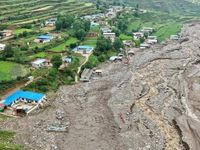On the evening of August 16, 2025, what was meant to be a peaceful camping trip on the grasslands of Inner Mongolia turned into a nightmare. At around 10 p.m. local time (14:00 GMT), a sudden flash flood swept through the Urad Rear Banner region, near Bayannur city, washing away a group of 13 campers. By Sunday afternoon, the aftermath was grim: nine people confirmed dead, three still missing, and only one survivor pulled to safety, according to Chinese state media reports cited by Xinhua and AFP.
The tragedy unfolded rapidly. The banks of a river running through the area burst, unleashing a torrent that overwhelmed the unsuspecting campers. State broadcaster CCTV reported that more than 700 workers were immediately mobilized for an urgent search and rescue operation, combing the flood-ravaged landscape for the missing. The Ministry of Emergency Management ordered a full-scale rescue effort and dispatched a working group to the scene, underscoring the severity of the disaster and the government’s determination to leave no stone unturned.
"We are doing everything in our power to find the missing and support the families affected," a spokesperson for the Ministry of Emergency Management stated, as cited by Xinhua. The urgency of the situation was palpable, with rescue teams battling muddy, fast-moving waters and treacherous terrain in the hope of finding survivors. Helicopters, boats, and sniffer dogs were all pressed into service, while anxious families waited for news.
This devastating flood is just the latest in a string of natural disasters that have battered China in the summer of 2025. The country has been grappling with weeks of extreme weather, with heavier-than-usual monsoon rains linked by experts to the ongoing climate crisis. The monsoon, which typically brings seasonal rainfall, has stalled over both northern and southern regions, unleashing downpours that have tested the resilience of communities and officials alike.
Bayannur, the city near the site of the tragedy, is a vital hub for China’s agricultural industry. Known as a national grain and oil production base and a center for sheep breeding and processing, the area’s economic stability is intimately tied to the land and weather. The flash flood not only claimed lives but also threatened the livelihoods of thousands who depend on the region’s farms and pastures. As state media noted, the economic impact of such disasters can run into billions of dollars, compounding the tragedy for those already struggling to recover from earlier storms.
Further south, the ripple effects of relentless rain have been felt in Hainan province. There, a three-and-a-half-month shipping suspension—imposed to protect vessels and crews from persistent, heavy downpours—finally ended on August 16. Agricultural affairs officials had ordered ships to shelter in port, disrupting trade and supply chains for months. The resumption of shipping was a small relief amid a summer defined by disruption and uncertainty.
The recent flood in Inner Mongolia is part of a broader, troubling pattern. Earlier in August, flash floods and mudslides in northwest China claimed at least 13 lives, while in late July, a deadly deluge struck Beijing. The capital’s rural suburbs were hit hardest, with at least 44 people killed and more than 70,000 residents forced to evacuate their homes, according to AFP. In nearby Hebei province, a landslide triggered by heavy rain took another eight lives, further highlighting the widespread nature of this summer’s disasters.
China’s central government has responded with a significant financial commitment. Last week, authorities announced an additional 430 million yuan (about $59.9 million) in disaster relief funding, bringing the total allocated since April to at least 5.8 billion yuan. The funds are intended to support rescue operations, provide aid to survivors, and help rebuild communities shattered by floods, landslides, and other natural calamities.
Weather experts and environmental scientists are increasingly linking this surge in extreme weather to the global climate crisis. The shifting monsoon patterns, heavier rainfall, and increased frequency of flash floods are seen as symptoms of a warming planet. As one meteorologist told state media, "We are witnessing the effects of climate change in real time, and it is testing our ability to respond and adapt." The challenge for officials is not only to manage immediate crises but also to invest in long-term solutions—improved infrastructure, better early warning systems, and more resilient communities—to withstand what may become the new normal.
The stories emerging from the flood zones are harrowing. In Bayannur, rescue workers described scenes of devastation: tents and belongings swept away, vehicles overturned, and muddy water still coursing through fields where sheep once grazed. "It happened so fast, we barely had time to react," one survivor reportedly told rescuers, echoing the shock and disbelief felt by many.
For those who lost loved ones, the grief is overwhelming. Local officials have set up support centers to provide counseling and assistance, while volunteers from across the region have joined the relief effort. The sense of solidarity is strong, but so too is the anxiety—will the next storm bring more destruction?
Natural disasters are not new to China, especially during the summer months. The country’s vast and varied landscape means that while some regions endure searing heat, others are deluged by rain. Yet, the scale and frequency of recent events have raised fresh questions about preparedness and resilience. As state media pointed out, the summer of 2025 has been particularly punishing, with each disaster compounding the difficulties faced by communities and authorities alike.
Looking ahead, officials are urging vigilance. The Ministry of Emergency Management has called for improved monitoring of weather patterns, better coordination among agencies, and increased investment in infrastructure designed to withstand floods and landslides. "We must learn from each disaster and strengthen our defenses," a ministry spokesperson emphasized in a televised briefing.
As rescue operations continue in Inner Mongolia, the nation watches anxiously, hoping for good news but bracing for more challenges. The events of August 16 serve as a stark reminder of nature’s power—and the urgent need for collective action in the face of a changing climate. For the families of the victims, and for communities across China, the road to recovery will be long and difficult, but the determination to rebuild is unwavering.





